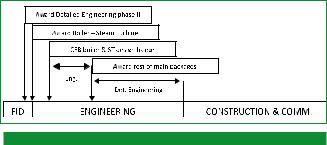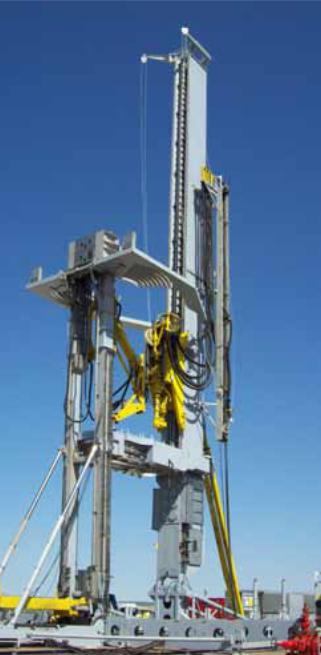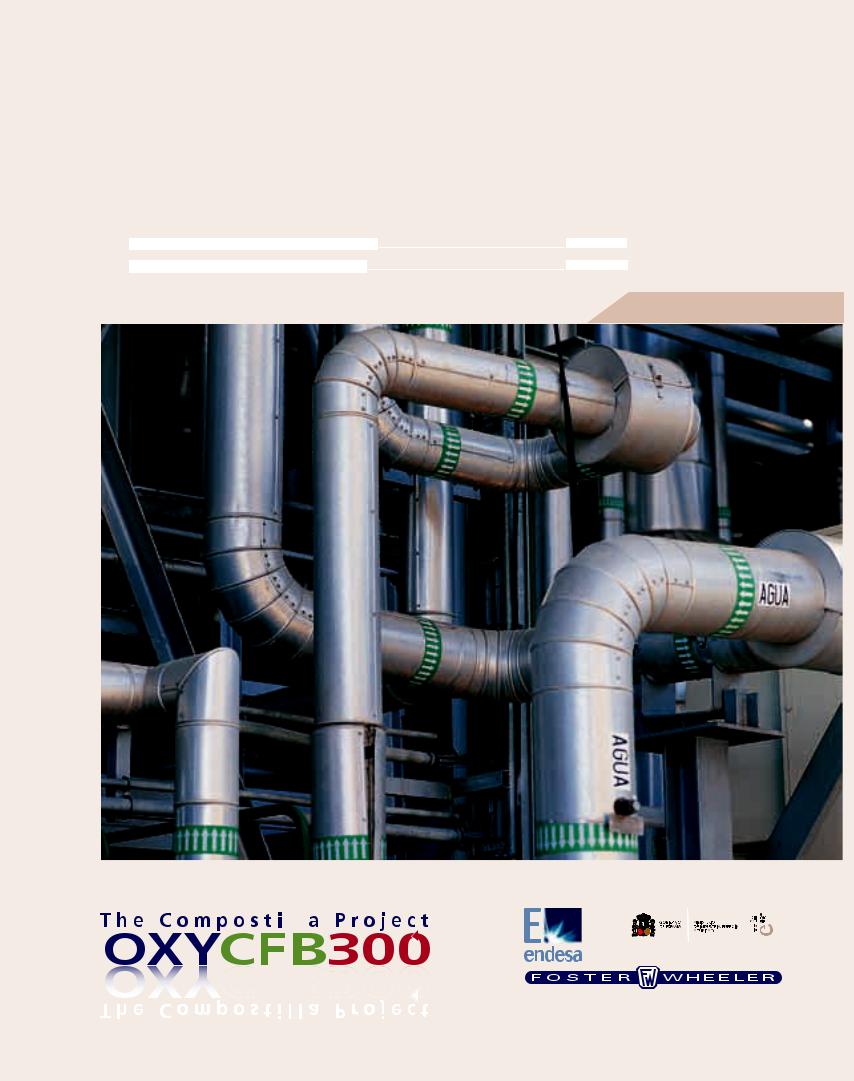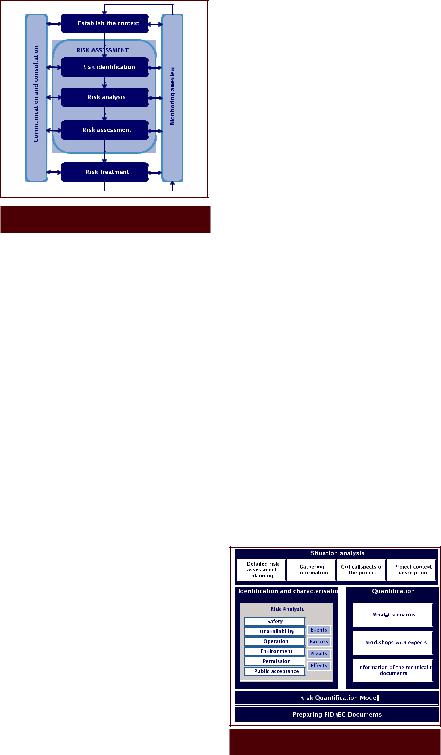
01 POWER ISLAND / 04 CO2 capture / Compostilla-project-OXYCFB300-FEED-report
.pdf
110 | |
OXYCFB300 COMPOSTILLA. CARBON CAPTURE AND STORAGE DEMOSTRATION PROJECT |
Problems in establishing clear scopes. A greater number of companies involved increases the likelihood of more change orders requests and additional works from contractors to the Property which may cause impact on the deadline.
Establishment of interfaces milestones and a general agreement on a single project schedule as a whole.
Special Contract Management to minimize potential individual claims for extension of deadline of each tender. In a situation of disputes caused by the occupation of work areas in construction due to a greater number of subcontractors are more likely than normal that claims for an extension of time occurs. Granting a contractor a grace period may cause modifications in the major subcontractors programs. That would be detrimental to the chance of achieving the original deadline set for the project.
The possibility of different endings between subcontractors - for example, because one of them has been granted a grace extension of timemay cause serious extra costs to the Property in recovery plans, as to keep contractors and vendors on site as well as maintaining conservation systems and equipment.
ment: Boiler and Turbine. Both will require small re-engineering efforts based on actual data from the equipment awarded. Once the studies are completed and modifications affecting the rest of competitions have finished too, promoters will be available to award the rest of packages providing a closed basic engineering.
Each package or tender shall be responsible for the detailed engineering of the corresponding scope. However electrical and civil detailed engineering of the Capture Project shall be fully responsibility of the Engineering Services Integration and oversight of Contractors. Feeding with documentation on time and shape the suppliers of electrical and civil works respectively.
The particular feature of such a project, where so many companies are involved from the beginning, is further accentuated when analyzing the drawbacks and difficulties that we can find at different stages such a project in industrial sector may contain: Engineering (basic and detail), construction and commissioning.
Clearly, the need for a greater control by the Promoters will be increased and will force the Project Management to develop a complex system of communication management, activities, planning, responsibilities, contracts, etc. The experience gained during the FEED in OXYCFB300 Plant shows that for the proper execution of the engineering, construction and commissioning should be given a series of sequences and very specific activity programs if you want to successfully complete the project within the estimated deadline. That is why here is a description of major patterns obtained after FEED regarding detailed engineering:
If we focus on the first steps to be taken, once the Project Promoters get a positive response from the FID, main packages contracted from plant should be noted as critical: Turbine and Boiler. This award should be carried out once the execution of the plant is confirmed due to the long supplying periods established. However, these packages require previous basic engineering that also directly impact on the rest of the plant equipment. For an integration of the work of the different tenders and monitoring construction tasks and implementation thereof, the Promoters of the project will require a contractor to provide engineering services integration and oversight. This company will be responsible for the previous works to the award of the main equipment of the plant and should, like the aforementioned teams, start works after taking decision or FID.
An integration and validation task of the completed work will be needed during the FEED adapted to a real award of the main equip-
Figure 8.2 Sequencing scheme-Phase II engineering works
8.2.3 Project Management Strategy
Due to the special characteristics of OXYCFB300 Compostilla Project, with a high degree of technological innovation, new developments and high budget, an EPC or turnkey contract has been ruled out as procurement option. Instead of that, ENDESA has considered the definition of different bidding processes or work packages as contracting strategy for the project. This new strategy of subcontracting, looking for packages specialization, is a challenge in interferences control and management due to the high number of different companies, particularly on site, being a limited physical area.
During the FEED phase of the project, the entire supply of the plant has been divided into different packages or bidding processes, whose scope and terminal points have been carefully defined in order to avoid scope duplications between different packages, as well as to avoid the non-inclusion of any of the items of the project.
To get out the request for proposal, a request for quotation (RFQ) document has been prepared for each of the work packages or bidding processes, which defines the scope thereof (including any exceptions or optional supplies), and integrates all the required technical documentation for the bid submitted to meet the required scope and design criteria set out in the project.
During the FEED final phase, requests for supply have been made of all equipment and facilities of the plant, selecting between 2 and 5 potential suppliers for each package (as long as market offer would allow it) and prioritizing the selection of Spanish or European com-
CHAPTER 8. OXYCFB300 IMPLEMENTATION |
| 111 |
panies. The subsequent bid comparison consisted of a technical and economic analysis of received bids, according to the evaluation criteria defined for each work package. A technical comparison of the bid has been issued for each work package in order to validate the scope offered, identifying possible exceptions and deviations from the specification.
During the work packages proposal preparation phase, engineering has answered all the technical questions and doubts raised by suppliers on their bid preparation.
8.2.4 Work Packages Description
8.2.4.1 Generation and Capture Plant
In an early stage of the FEED phase, the Generation and Capture Project was divided into 30 different packages or bidding processes, although during their definition and developing phase it was found that this division was not optimal for the efficient execution of the project, identifying difficulties in the interface definition as well as disciplines mixture between several work packages. The number of work packages was reduced to 18, thus facilitating the bidding processes supply and simplified interphases, obtaining more appropriated and standardized scopes.
8.2.4.2 Piping and Onshore Facilities
The CO2 Transport and Injection Project were divided into three (3) different work packages.
8.2.4.3 Storage and Subsurface Engineering
This subcontracting strategy for Storage Demo Plant aims for direct relationship with the various lines of services, and implies a challenge in management of interfaces, contracts and suppliers, especially to site works. Nevertheless, this scheme is the usual practice in the oil industry, and therefore has been assumed by Endesa, based on the previous experience during the phase I, as the most adequate, although the EPC contracting mode still remains open (with the risk of complex contract management if Technical Specifications are not precise).
The CO2 Storage Project has been divided into thirty six (36) work packages.
8.3 OXYCFB300 IMPLEMENTATION PROGRAMME
8.3.1 Tasks Identification and General Description of the Implementation Phase
The programme presented covers all the construction activities to be performed since positive FID after Final Investment Decision process completion. The endpoint of the programme considered is the OXYCFB300 Compostilla Demo Plant completion after the construction period ready to perform the expected 5 first years of CCS technology demonstration period.
The implementation programme is divided into three main work areas: capture (construction of the Capture Power Plant), transportation (construction of the transport pipeline and associated injection facilities) and storage (construction of the injection and monitoring wells). Other activities to be run all along the construction (permitting, knowledge sharing, public acceptance, funding and investors management, stakeholders management, project management and others) are reflected either as project milestones, continuous activities or not reflected at all, with the understanding that even though are necessary for successfully completing the construction project but not on the critical path.
Commissioning for all the facilities, including integrated commissioning for the CCS chain, is reflected in the presented implementation programme. Further tuning activities of the CCS chain operation and Demo Plant improvements during the 5 first years of CCS technology demonstration period are not reflected. An exponential learning curve for those 5 years is expected.
Accordingly to what depicted above, the implementation schedule (if a positive final investment decision is taken) is expected to be run in between the following dates:
FID completion: foreseen October 2013.
Demo Plant construction completion: foreseen June 2018. Estimated construction period: 56 months.
8.3.2 Critical Path
Critical paths are diverse and certainly not just a single one in such a complex programme, as delay risk of each activity can make that one of several paths that was not considered as critical at the beginning would become critical. All the EEPR technological development activities performed during 2010, 2011, 2012 and early 2013 converge on a single clear and rigid-fixed milestone, the Final Investment Decision (FID), which is scheduled to be concluded for 31st October 2013, and this milestone is considered as the starting point for calculating the implementation schedule. The end point considered is the CCS chain operation start. Between both, the main critical paths identified during management of the project and FEED programme were the following:
Regarding Oxyfuel (OXYCFB300) Capture Demo Plant, critical path goes through main equipment manufacturing (especially

112 | |
OXYCFB300 COMPOSTILLA. CARBON CAPTURE AND STORAGE DEMOSTRATION PROJECT |
Turbine Island, Boiler Island, and ASU and CPU units), construction and erection, and commissioning. Of all the equipment, the pre-engineering, manufacturing, delivery, erection and commissioning of the turbine island settles the critical path, as 56 months are needed for completing all the supply contract for this item. The main reason for this higher-than-expected period is that the supercritical steam turbine is not commercial equipment and needs specific development for this project. Other equipment and plants completion periods are pushed backwards by this period, as final commissioning of the plant can only be completed when all the systems are ready.
Regarding transport pipeline, critical path goes through CO2 transport pipeline land permits, purchasing, manufacturing and construction. Despite of the fact that transport activities are also critical for CCS full chain operation start, transport pipeline schedule show significant floats comparing to capture plant schedule. Because of the calculated floats, there are no expectations of critical path due to agreements with land owners, even if delays occur.
Regarding storage reservoir, critical path goes through the injection engineering, long lead items procurement, and injection and monitoring wells drilling.
8.3.3 Key Dates
Next chart shows main milestones expected and envisaged month of achievement scheduled in the implementation programme of the demonstration plant:
MILE- |
DEMO |
DEMO PLANT CONSTRUCTION MILESTONE |
SCHED- |
|
STONE |
PLANT |
ULED |
||
NAME |
||||
NO. |
AREA |
MONTH |
||
|
||||
C1 |
Capture |
NTP for engineering works |
- 6 |
|
C2 |
Capture |
NTP main equipment award (turbine |
0 |
|
island & CFB boiler) |
||||
|
|
|
||
C3 |
Capture |
Heat / Water balance completed |
0 |
|
C4 |
Capture |
Permits available |
0 |
|
C5 |
Capture |
Access to site ready |
0 |
|
C6 |
Capture |
Site services available for construction |
2 |
|
C7 |
Capture |
ASU/CPU NTP award |
4 |
|
C8 |
Capture |
BOP NTP award |
6 |
|
C9 |
Capture |
Turbine Building Steel Structure Final |
8 |
|
Drawings |
||||
|
|
|
||
C10 |
Capture |
Electrical & I&C Supply & Erection NTP |
11 |
|
award |
||||
|
|
|
||
C11 |
Capture |
Boiler foundation finished |
13 |
|
C12 |
Capture |
Turbine pedestal finished |
16 |
|
C13 |
Capture |
Boiler main structure finished |
19 |
|
C14 |
Capture |
ASU & CPU main steel structure finished |
23 |
|
C15 |
Capture |
Solids handling erection start |
26 |
|
C16 |
Capture |
Overhead Crane Operative |
30 |
|
C17 |
Capture |
DCS FAT |
30 |
|
C18 |
Capture |
Condenser Lower Water Boxes delivered |
31 |
|
to site |
||||
|
|
|
C19 |
Capture |
MV power supply available for |
33 |
|
precommissioning |
||||
|
|
|
||
C20 |
Capture |
Raw water available for precommissioning |
33 |
|
C21 |
Capture |
DCS Cabins delivered to site |
33 |
|
C22 |
Capture |
Demin water available |
36 |
|
C23 |
Capture |
HV connection to grid available |
37 |
|
C24 |
Capture |
Start Boiler Hydro Test |
37 |
|
C25 |
Capture |
Main Transformer Energized |
37 |
|
C26 |
Capture |
Cooling System Available |
39 |
|
C27 |
Capture |
Fuel oil available for first fire (with aux. |
41 |
|
Fuel) |
||||
|
|
|
||
C28 |
Capture |
Fire on oil |
41 |
|
C29 |
Capture |
Coal available for first fire (with coal) |
44 |
|
C30 |
Capture |
Steam to Turbine |
45 |
|
C31 |
Capture |
Generator Synchronization |
45 |
|
C32 |
Capture |
Fire on coal |
46 |
|
C33 |
Capture |
Construction acceptance |
50 |
|
C34 |
Capture |
CCS Chain operation start |
50 |
|
T1 |
Transport |
Project Kick-Off |
0 |
|
T2 |
Transport |
Environmental & Construction permits |
0 |
|
available |
||||
|
|
|
||
T3 |
Transport |
Pipe and valves procurement start |
6 |
|
T4 |
Transport |
Construction award |
18 |
|
T5 |
Transport |
Release of land and all local permits |
22 |
|
obtained |
||||
|
|
|
||
T6 |
Transport |
Construction Kick-Off |
23 |
|
T7 |
Transport |
Pipeline on site |
23 |
|
T8 |
Transport |
Main valves on site |
23 |
|
T9 |
Transport |
Transport start-up in isolated mode |
34 |
|
T10 |
Transport |
Transport start-up in CCS mode |
46 |
|
T11 |
Transport |
CCS Chain operation start |
50 |
|
S1 |
Storage |
Project kick-off |
0 |
|
|
|
Wellheads, casing and tubing |
|
|
S2 |
Storage |
procurement for Injection & Monitoring |
6 |
|
|
|
wells completed |
|
|
S3 |
Storage |
Basic Design Drilling Program ready (5 |
7 |
|
wells) |
||||
|
|
|
||
S4 |
Storage |
2D seismic & micro seismic campaigns |
11 |
|
completed |
||||
|
|
|
||
S5 |
Storage |
Baselines and InSAR activities completed |
16 |
|
S6 |
Storage |
Long Lead items for Injection & Monitoring |
19 |
|
|
|
wells supplied |
|
|
S7 |
Storage |
First injection well drilling completed |
22 |
|
S8 |
Storage |
Second injection well drilling completed |
26 |
|
S9 |
Storage |
Third injection well drilling completed |
30 |
|
S10 |
Storage |
Hydrogeological monitoring wells |
33 |
|
completed |
||||
|
|
|
||
S11 |
Storage |
Monitoring wells drilling completed |
39 |
|
S12 |
Storage |
Storage start-up in CCS mode |
46 |
|
S13 |
Storage |
CCS Chain operation start |
|
|
50 |
||||
|
|
|
|
Table 8.1 Main milestones expected and envisaged month of achievement
schedule.

CHAPTER 8. OXYCFB300 IMPLEMENTATION |
| 113 |
8.4 DECOMMISSIONING AND PROJECT ABANDONMENT
ENDESA establishes three fundamental objectives that should be accomplished during the period which starts at the cessation of injection and specifies the systematic process to be followed to demonstrate and document compliance with these objectives. The three objectives are as follows:
Sufficient understanding of the storage site’s characteristics;
Low residual risk; and
Well integrity that is adequate and uninterrupted for a period of time as set by the designated authority.
8.5 OXYCFB300 RESOURCES
8.5.1 Execution Phase
A resources allocation study has been done based on the implementation programme. Next charts and graphs show the expected manpower resources for the construction of the demonstration plant, including:
Planned man-month, total (including engineering, design and management teams) or at Compostilla construction site only; during project construction timeline.
Manpower curve during project construction timeline, and manpower hours classified by execution stage.
Hours in manpower resources classified by type of work. Expected workforce cost cash flow based on resources needs estimation (for illustrative purposes only).
8.5.2 Operation and Maintenance
A team of 50 to 75 people is estimated for permanently operating and maintaining the Capture Power Plant. Extra human resources will be needed for major overhauls and for the 5 first years of experimental operation.
Regarding transportation and storage operation, the control concept designed allows operating in remote control from the capture plant, without on-site operators. Nevertheless it is envisaged that an extra staff of 10 to 20 people will be necessary for permanent maintenance and monitoring of transport, injection and storage facilities. Also extra human resources will be needed for major overhauls and for the 5 first years of experimental operation.

|
9.1 |
Objetives, Scope and Status |
117 |
|
|
|
|
|
||
|
|
|||||||||
|
9.2 |
OXYCFB300 Risk Register |
118 |
|
|
|
|
|||
|
|
|
|
|
|
|
|
|
|
|
|
|
|
|
|
|
|
|
|
|
|
|
|
|
|
|
|
|
|
|
|
|
|
|
|
|
|
|
|
|
|
|
|
|
|
|
|
|
|
|
|
|
|
|
|
|
|
|
|
|
|
|
|
|
|
Access to and use of the information ¡n this document ¡s subject to the terms of the important notice at the front of the document

9
OXYCFB300 Risk Analysis

116 | |
OXYCFB300 COMPOSTILLA. CARBON CAPTURE AND STORAGE DEMOSTRATION PROJECT |
Index
9.1 Objetives, Scope and Status . . . . . . . . . . . . . . . . . . . . . . . . . . . . . . . . . . . . . . . . . . . . . . . . . . . . . . . . . . . . . . . . . . . . |
117 |
9.2 OXYCFB300 Risk Register . . . . . . . . . . . . . . . . . . . . . . . . . . . . . . . . . . . . . . . . . . . . . . . . . . . . . . . . . . . . . . . . . . . . . . 118
List of Figures |
|
|
Figure 9.1 |
Risk management process. . . . . . . . . . . . . . . . . . . . . . . . . . . . . . . . . . . . . . . . . . . . . . . . . . . . . . . . . . . . . . |
117 |
Figure 9.2 |
Conceptual framework for the Comprehensive Risk Assessment . . . . . . . . . . . . . . . . . . . . . . . . . . . |
117 |
List of Tables |
|
|
Table 9.1 |
Assessment of Risks initially qualified as Extreme after mitigation measures application . . . . . . |
118 |
Table 9.2 |
Conclusions based on the Global Risk Assessment. . . . . . . . . . . . . . . . . . . . . . . . . . . . . . . . . . . . . . . . |
118 |

CHAPTER 9. OXYCFB300 RISK ANALYSIS |
| 117 |
9.1 OBJETIVES, SCOPE AND STATUS |
Sometimes the definition of the above sec- |
Any business project requires the manage- |
tions is unclear and the classification of |
ment of the risks inherent to the project. |
some risks may be debatable. |
In large projects such as this one with a significant level of investment, a high recovery period, a lengthily period required for research, design, construction and a complex operation, it is necessary to carry out an explicit definition of a risk management methodology which should begin in the first phases of the project and continue throughout its development to completion. This kind of project includes different types of risks that need to be managed and which may be grouped into the following main sections:
Operational risks
Market risks
Business/ regulation risks
Operational risks are defined as any loss of value resulting from the occurrence of events caused by the inadequacy or failure of critical equipment, processes, breach of legislation or arising from external factors. Operational losses include economic, noneconomic and reputational effects.
Market risk relates to potential losses due to changes in the price levels of commodities, exchange rates, interest rates and other products or indices listed on the market.
Business risks cover those risks which involve possible losses due to external factors such as the regulatory framework, economic cycles, competition levels, demand patterns, industry structure, together with other factors. This group also includes the risk of losses resulting from unsuitable decisions regarding the Consortium’s business plans and future strategies. A particularly relevant risk within this typology is the regulatory risk, which is that linked to the regulatory framework in which business activities take place.
Business risks also encompass risks associated with project funding. In this sense it is necessary to consider the risks associated with the financing structure, debt instruments considered, the level of leverage, variability of interest rates, the term of the debt, the guarantees required and the particularities of the contractual clauses in general.
Risk management is a process divided into the following stages:
|
Figure 9.1 Risk management process.
[Methodology according to ISO 31000 and ISO 31010]
All the work framed within the Comprehensive Risk Assessment is aimed at achieving the objectives set out below:
Conduct a comprehensive assessment of risks for OXY-CFB-300 Compostilla project. Identify significant risks for the purposes of the project feasibility.
Identify differential risks of this technology not shared by conventional technologies. Quantify the risks analysed, as appropriate depending on their nature.
Prioritise risks and analyse in detail those which are most critical.
Support for the final investment decision (FID).
Comprehensive Risk Assessment has been developed according to a conceptual framework based on the following principles and relevant aspects:
Situation analysis
Detailed risk assessment planning. Identification of those responsible and experts involved in the project, and the prior development of a schedule showing the working groups that will participate in the risk identification and quantification of each of the areas.
Gathering information. Gathering basic project documentation, technical risk documentation, project planning, operating parameters and costs.
Preparation of a document including the critical aspects of the project. Identification of the specific and differential elements (technological, regulatory, contractual, market, etc.) of OXY-CFB-300 Compostilla project.
Project context description. Contextualising OXY-CFB-300 Compostilla project: An overview of the global energy scenario, considerations regarding capture technology, the geological storage and the main alternatives.
Risk identification, characterisation and quantification based on the best suited (available?) methodologies and processes for each type of risk.
Risk Quantification Model (MCR, Spanish acronym). The MCR is used to measure risks associated with delays in the planning and obtaining of permissions, and to perform specific analyses (sensitivities, simulations) of critical variables.
Preparing final documentation. Preparation of the final documents described in the DOW (D1.6, D2.2 and D3.4, codes associated with the deliverables of risk assessment for the capture, transport and storage areas respectively).
The work carried out under the Comprehensive Risk Assessment is subject to the limitations listed below:
Limitations associated with the level of engineering development.
Not including risks identified during the engineering development stage which have been closed prior to the FID.
Limitations on the integration of the quantitative results derived from the different nature of the risks covered.
|
Figure 9.2 Conceptual framework for the Com-
prehensive Risk Assessment

118 | |
OXYCFB300 COMPOSTILLA. CARBON CAPTURE AND STORAGE DEMOSTRATION PROJECT |
9.2 OXYCFB300 RISK REGISTER
Once all the global quantitative risk assessment for the project, the project team proposed a set of mitigation measures to reduce the risk as much as reasonable possible. The team focused on risks categorized
as extreme, as those are highly influential for the Final Investment Decision process.
The following table shows how a second assessment of the same risks -assuming that
the additional mitigation measures proposed were implementedwould change the extreme risk category as shown in the following table:
Nº |
RISK |
INITIAL |
POST-MITIGATION |
|
CATEGORY |
CATEGORY |
|
||
|
|
|
||
1 |
Uncertainty in the plant scaling based on the experience of the pilot plant resulting in a performance of |
Extreme |
Extreme |
|
plant components during operation which is lower than anticipated in design |
|
|||
|
|
|
|
|
2 |
Strong dependency on suppliers in charge of constructing the injection and monitoring wells |
Extreme |
Moderate |
|
|
|
|
|
|
3 |
High dependence on the boiler supplier in Stage II as a result of the technology development in Stage I, |
Extreme |
High |
|
which can lead to delays in construction or investment cost deviations |
|
|||
|
|
|
|
|
|
|
|
|
|
4 |
Failure in the first stage of CPU compression in the event that the removal of particles and / or the |
Extreme |
Moderate |
|
desulphurisation is not correctly carried out in the first stage of purification of exhausts gases. |
|
|||
|
|
|
|
|
|
|
|
|
|
5 |
Much longer execution terms than those planned due to the technical complexity of the project (the |
Extreme |
High |
|
incorporation of new technologies, new suppliers or other differences) compared to a |
|
|||
|
|
|
|
|
6 |
Errors in the preparation of contracts due to lack of previous references for contracts for this type of |
Extreme |
High |
|
technology |
|
|||
|
|
|
|
|
7 |
Increased time commitment of technologists during testing period derived from technology uncertainties |
Extreme |
High |
|
and due to difficulties associated with equipment integration |
|
|||
|
|
|
|
|
|
|
|
|
|
8 |
Air infiltration in the boiler |
Extreme |
High |
|
|
|
|
|
|
9 |
Opposition of communities and environmental organisations in the area to CO2 storage operation, |
Extreme |
High |
|
resulting in a loss of social support and public acceptance of the project |
|
|||
|
|
|
|
|
10 |
Errors and / or delays in the communication and interaction between the various parties involved in the |
Extreme |
Moderate |
|
project |
|
|||
|
|
|
|
|
|
|
|
|
|
11 |
Errors due to inadequate definition of technical specifications by the company, the misinterpretation of |
Extreme |
High |
|
the technical specifications by suppliers or the complexity of integrating the different plant units |
|
|||
|
|
|
|
|
|
|
|
|
|
12 |
Delays in the processing of permits that are in progress or pending at the time of the FID with regard to |
Extreme |
Extreme |
|
statutory timeframes due to the novel nature of the project. |
|
|||
|
|
|
|
|
|
Failure to obtain permits that are in progress or pending at the time of the FID and which are required |
|
|
|
13 |
for the construction and operation due to the novelty of the project, to the possible Highly restrictive |
Extreme |
Extreme |
|
technical requirements set by the Public Authorities for obtaining permits due to the novelty of the |
|
|||
|
|
|
|
|
|
project, its potential lack of public acceptance or other factors. |
|
|
|
|
|
|
|
|
Table 9.1 Assessment of Risks initially qualified as Extreme after mitigation measures application |
|
|
|
|
The fact that there is little previous experience and that subjective aspects can affect the occurrence of certain risks -such as project public acceptance or support from the public authoritiesmeans that the quantification of the identified risk events has not been possible in some certain cases. Specifically, the quantification of the two risks shown in the next table has not been possible; however they must be taken into account in the project risk monitoring and management process.
The findings are divided into three sections: risk assessment based on questionnaires
completed by a team of experts, further assessment based on stochastic simulations and finally additional considerations regarding other risk types.
Conclusions based on the expert assessment
Of the 74 elements that make up the list of major risks, 13 have been rated as extreme. Assuming that the proposed mitigation measures were applied, 10 of the 13 risks would become high or moderate. There are three risks whose rating remains as extreme despite potential mitigation measures and which should ideal-
ly be analysed in depth and be monitored separately. These risks are the following:
-Uncertainty in the scaling-up of the plant based on pilot plant data resulting in a lower performance of the plant in operation than those stipulated in the design.
-Delays in the processing of permits that are in progress or pending at the time of the FID with regard to statutory timeframes due to the novel nature of the project.
-Failure to obtain permits that are in progress or pending at the time of the
|
Nº |
|
RISK |
|
LEVEL OF RISK |
|
CATEGORY |
|
1 |
|
Permitting delays due to the lack of specific regulations defining the process for obtaining the required |
|
- |
|
- |
|
|
|
|
||||
|
|
administrative authorization for the construction and operation of CO2 ducts. |
|
|
|||
|
|
|
|
|
|
|
|
|
2 |
|
Highly restrictive technical requirements set by the Public Authorities for obtaining permits due to the |
|
- |
|
- |
|
|
novelty of the project or its potential lack of public acceptance. |
|
|
|||
|
|
|
|
|
|
|
Table 9.2 Conclusions based on the Global Risk Assessment
CHAPTER 9. OXYCFB300 RISK ANALYSIS |
| 119 |
FID and which are required for the construction and operation due to the novelty of the project, to the possible Highly restrictive technical requirements set by the Public Authorities for obtaining permits due to the novelty of the project, its potential lack of public acceptance or other factors.
The study area in which most risks have been identified is the capture area, amounting to 31 of which 5 are extreme. This is due to the technological complexity of this area and the important research and development component.
Regarding storage, of the 18 risks assessed, 2 have been assessed as extreme, although additional mitigation measures have been identified for both. The risk profile for this area has improved thanks to reservoir characterisation tasks that have significantly reduced the uncertainty regarding the technical feasibility of the reservoir.
Additional mitigation measures have not been identified for two of the extreme risks associated with the project permitting area, so their final rating remains as extreme.
The very nature of these risks makes their management difficult for the Consortium, because the role of the public authorities is decisive in both cases. Furthermore, the lack of a specific law that applies to the transport of CO2 by pipeline, makes it extremely difficult to proceed with the associated permits.
It is compulsory for risks rated as extreme to be mitigated and this will require the appointment of persons responsible and regular monitoring mechanisms. For risks rated as high, an in-depth review is advisable to verify if they comply with the ALARP criterion; additional risk reduction measures should be analysed where appropriate.
A more detailed definition of risk managers (both internally and externally) is considered advisable at future stages in order to improve the monitoring and mitigation of risks.
Lastly, regarding the suppliers or other stakeholders, the Consortium should promote their active involvement in the risk monitoring and mitigation process.
Considerations regarding other risk types
The Compostilla OXY-CFB-300 project is exposed to the uncertainty inherent in different market, business and regulatory variables.
The prices of CO2 emission allowances determine the main competitive advantage of the project. The greater investment with regard to a conventional thermal plant associated with the capture, transport and storage installations means that much higher market prices than those existing are required to make it economically viable.
There is uncertainty regarding the regulation of CO2 emissions in the medium / long term. In this regard, the most recent decisions ratified by the European Parliament rejecting the Commission’s proposal to delay the auctioning and marketing of new emissions allowances for the 2013-2015 period won’t contribute to increase the low prices currently observed in the market.
The lower performance of this plant compared to a conventional power plant implies a greater exposure to fuel prices per MW installed.
The project is exposed to further possible regulatory changes that could affect its economic viability. The sector restructuring process is still in progress, and a new package of measures has been announced. Therefore, uncertainty surrounds the possible impact of such new measures on the various activities of the sector and how investor perceptions of the regulatory stability thereof may be affected.
These legislation amendments for the sector could hinder the development of a regulatory framework for the project itself, or for CCS technologies in general, intended to encourage commercial development thereof.
The pent-up electricity demand scenario and the increased weight of renewable energy types under the special regime in the electricity mix are leaving ever less room for other electricity generation technologies.
There is uncertainty regarding the evolution of oxy-fuel technology and of saline formation storage technology in relation to other capture technologies.
CCS technologies require a higher investment than conventional power plants; this implies a much lower profitability than other conventional technologies and this is not helped by the lack of a specific regulatory framework to promote the development of these technologies.
Social acceptance on this technology is still unknown entailing the risk of being rejected as an alternative to other technologies.
